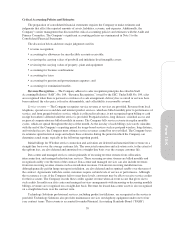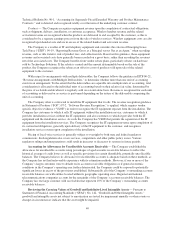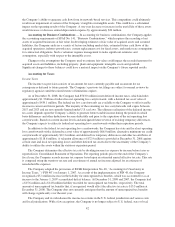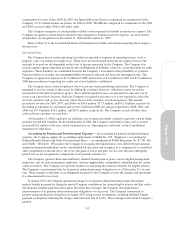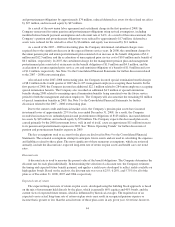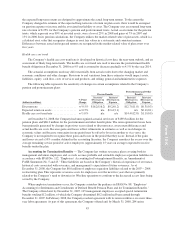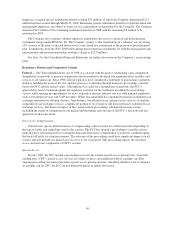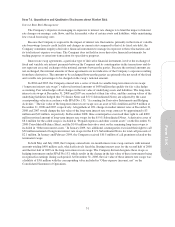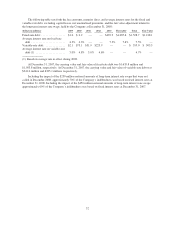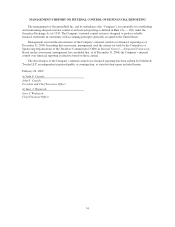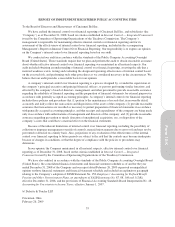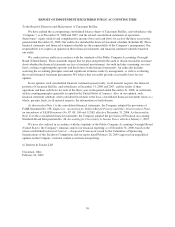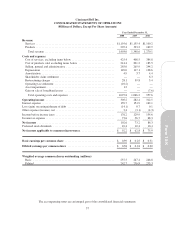Cincinnati Bell 2008 Annual Report Download - page 147
Download and view the complete annual report
Please find page 147 of the 2008 Cincinnati Bell annual report below. You can navigate through the pages in the report by either clicking on the pages listed below, or by using the keyword search tool below to find specific information within the annual report.
VoIP
In 2004, the FCC declared that VoIP services are interstate services and purported to preempt state
regulation. Since then, the FCC has considered several petitions asking it to rule on whether and under what
circumstances voice services utilizing Internet Protocol (IP) are subject to access charges. It has ruled that
peer-to-peer internet voice services that do not use the public switched telephone network (“PSTN”) are not
subject to access charges. Separately, it has ruled that services that originate and terminate on the PSTN but
employ “IP” in the middle are subject to access charges. The FCC is still considering other VoIP petitions,
including one that seeks to exempt from access charges calls that originate using VoIP, but terminate on the
PSTN. In addition, the FCC is considering a broader rulemaking proceeding to determine the regulatory status of
IP-enabled services generally. The FCC has expanded 911, universal service funding, and local number
portability requirements to interconnected VoIP providers.
Universal Service
The federal Universal Service Fund is currently funded via an assessment on all telecommunications
carriers’ and interconnected VoIP providers’ interstate end-user revenue. The FCC is currently considering
alternatives to this method of funding. Some of the alternatives being considered include switching to an
assessment based on telephone numbers and connections. Any such alteration could result in a change in the
manner in which carriers recover their contributions from end users.
Broadband Internet Access
In an order adopted in 2005, the FCC provided wireline carriers the option of offering broadband internet
access as a non-regulated information service (comparable treatment to cable modem internet access) or as a
regulated telecommunications service. In 2007 CBT elected the non-regulated information service designation
for its broadband internet access service. In 2007, the FCC ruled that wireless broadband service is also a
non-regulated information service on the same regulatory footing as other broadband services, such as cable
modem service and wireline DSL service.
FCC Safeguards to Protect Customer Proprietary Network Information (“CPNI”)
On April 2, 2007, the FCC released an order implementing new CPNI rules designed to prevent pretexting
to gain access to customer information. The new rules, which became effective in December 2007, require
carriers to implement security protections limiting the manner in which certain customer information may be
released and requiring notice to customers regarding certain types of changes to their account and CPNI
breaches. Carriers must file an annual certification with the FCC that they are compliant with the rules, including
a summary of actions taken in response to customer complaints.
State—Because CBT generates the majority of its revenue from the operation of its public switched
telephone network, its financial results follow no particular seasonal pattern. CBT does derive a significant
portion of its revenue from pricing plans that are subject to regulatory overview and approval. In both Ohio and
Kentucky, CBT operates under alternative regulation plans in which CBT is subject to restrictions on its ability to
increase the price of basic local service and related services. In return, CBT is not subject to an earnings cap or
recapture in Ohio, as it would if regulated under a traditional regulatory plan based upon a targeted rate of return.
CBT has operated under alternative regulation plans since 1994 during which price increases and enhanced
flexibility for a limited number of services have partially offset the effect of fixed pricing for basic local service
and reduced pricing for other, primarily wholesale services.
In June 2004, CBT adopted a new alternative regulation plan in Ohio, which, although similar to its
previous plan, gives CBT the option to remain in the alternative regulation plan indefinitely. Statutory changes
enacted by the Ohio General Assembly in August 2005 gave the PUCO the authority to provide ILECs with
pricing flexibility for basic local rates upon a showing that consumers have sufficient competitive alternatives
47
Form 10-K




